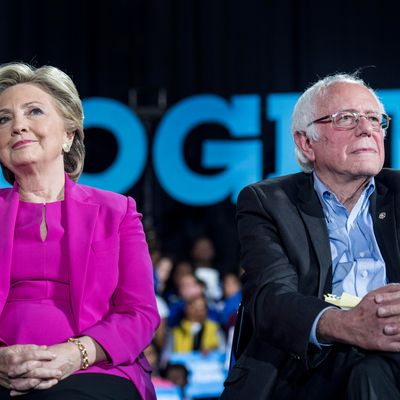
Four years ago, Bernie Sanders put up a surprisingly strong fight against Hillary Clinton on the strength of his support among white working-class voters, who proceeded to desert Clinton in November. On the basis of those two elections, the left quickly formed a series of conclusions. The working class had become alienated by neoliberal economics and was searching for radical alternatives. Because the Democrats had failed to offer the kind of progressive radical alternative Sanders stood for, voters instead opted for Trump’s reactionary attack on globalism. In order to win them back and defeat Trump, Democrats needed to reorganize themselves as a radical populist party.
On the left, this explanation was accepted so widely it became foundational, a premise progressives would work forward from without questioning its veracity. The Sanders campaign argued that its connection to the white working class would enable Bernie to compete in areas that had abandoned Democrats years ago. “Some in the Sanders camp envision possibly making a play for Iowa, Ohio, and Indiana, as well as states such as Kansas, North and South Dakota, Nebraska, Oklahoma and Montana,” reported Politico one year ago. Every left-wing indictment of the Democratic mainstream was made in explicit or implicit contrast to this imagined counterfactual of a Sanders-led party riding triumphant through the heartland of red America.
Even before any votes were cast in the primary, cracks were opening up in this analysis. A close look at the 2016 primary data showed that many of Bernie’s white working-class supporters were the same voters who had swung to Hillary Clinton in 2008 — they were protest votes against the Democratic Party, not affirmations of socialism. Polling on economic conditions swung dramatically positive as soon as Trump was elected, and even though Trump merely continued the same growth trajectory he’d inherited, the approval of his handling of the economy has hovered well above his overall approval. Trump’s ability to rebrand the same expansion and make it popular suggests the economy itself was not the source of the electorate’s discontent in 2016.
And then in 2018, leftists insisted Democrats were making a catastrophic error by nominating moderates to contest swing districts, rather than Sanders-style populists. The lack of a sharp left-wing economic message would surely prevent the upsurge in turnout Democrats needed to take the House. That prediction also failed. Democrats produced a wave election on behalf of moderate voters.
The second Sanders campaign has shown conclusively how badly the left misunderstood the electorate. It is not just that Sanders has failed to inspire anything like the upsurge in youth turnout he promised, or that he has failed to make meaningful headway with black voters. White working-class and rural voters have swung heavily against him. In Missouri and Michigan, those voters turned states he closely contested four years ago into routs for his opponent. Some rural counties have swung 30 points from Sanders 2016 to Biden 2020. The candidate in the race who has forged a transracial working-class coalition is, in fact, Joe Biden.
The factor that actually explains 2016, as some of us chagrined liberals insisted at the time, was Hillary Clinton’s idiosyncratic personal unpopularity. It turned out large portions of the public, even of the Democratic electorate, simply detested her. Sexism is obviously a very large reason, along with Clinton’s own mistakes and the media’s frequently unfair coverage of her. But the important thing is that Clinton’s toxic standing among wide swaths of the electorate was the gravitational force causing the phenomenon Bernie fans misread. Clinton hatred allowed Sanders to draw more than 40 percent of the primary vote, and Clinton hatred allowed Donald Trump to narrowly win.
The left was correct that it could mobilize a sizable faction within the party, dominated by the young, to demand more progressive ideas than the party had traditionally advocated. It is probably true that one day this faction will command a majority of the party and have the ability to reshape the terms of the national debate. (I certainly hope so.)
But Bernie’s loss, and the decisive manner in which it has occurred, should resolve any lingering debate over what caused the 2016 result. Hillary Clinton’s problem was not that she was too moderate, the white working class has not been radicalized — nor, for that matter, has the black working class — and Trump does not represent some final stage of capitalism. Sanders has inspired a sizable faction of one party. But his vision of mobilizing a hidden national majority is, and always was, a fantasy.






























